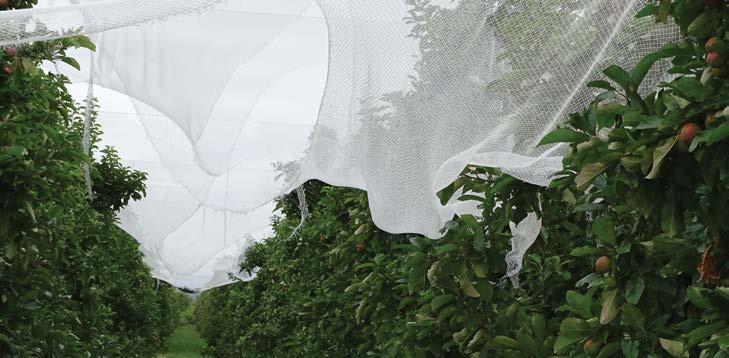
3 minute read
All hailed out at top of the south
The weight of hail proved too much for some hail netting
Hail-hit Tasman growers need help to retain permanent staff because they won’t have any income for 18 months or longer.
By Anne Hardie
The Boxing Day hailstorm cost the region an estimated $100 million through loss of income and damage, and that is before the flow-on effects around the region.
It has been described as the worst hailstorm in living memory in the region, wreaking havoc on a big chunk of horticultural land stretching from Riwaka around Motueka and through to Lower Moutere. The rest of the region was also peppered with hail, but it was the storm around Motueka that delivered the brutal damage. Pipfruit, kiwifruit, hops, berries and vineyards all got hammered. Some 300ha of this year’s apple crop was wiped out; two million trays of gold kiwifruit and 300,000 trays of green, half of around 150ha of hops decimated and about half the crop of 40ha of grapes lost. New Zealand Apples and Pears chief executive Alan Pollard says one of the biggest challenges for the hardest hit growers is retaining their permanent staff when they face no income for the next 18 months or more, but will have ongoing costs. He visited the region in mid-January when around 60 hail-affected growers attended a meeting with consultants, the Ministry for Primary Industries, the Ministry of Social Development and the Top of the South Rural Support Trust. He says some of the key aspects in the wake of the storm are managing and retaining staff, plus the mental health of growers who are facing huge stress, particularly financial.

Kiwifruit hammered by hail
Despite the prospect of no income for many apple growers this year, they now face the task of getting the damaged fruit off the trees and getting their trees back into shape. That will require even more labour than if they had picked a good crop off the trees, he says. “We need more labour now because you still have to get the fruit off the trees and practice some really strict tree husbandry. You don’t want disease occurring, so there’s more work now.
“The trees are looking very stressed and it’s highly likely there will be an impact into next season. It will depend on getting the fruit off at the right time.” He says it could be three to five years of ongoing costs for affected orchards because of the damage to trees and the possibility trees may become biennial bearing. He says hail usually sweeps through a relatively narrow corridor, but this storm had a wide sweep and he stood on one 600sq m block of orchard that didn’t have one piece of fruit left untouched.
The region no longer has a juicing facility and though there have been talks about trying to get it up and running for this year’s damaged fruit, he says it probably wouldn’t be financially worthwhile for growers to pick the fruit for juice anyway. In the wake of the storm, he says there will be more talk about hail netting options and the industry has asked the government for accelerated depreciation of hail netting so growers can get tax relief from the netting faster. Various forms of hail netting are already widely used in the region and Alan Pollard says growers are likely to put up more netting as it becomes more cost effective and as extreme weather events such as this hailstorm become more prevalent. This storm proved too much for hail netting on some blocks, especially flat-top netting. Boulke Hoekstra is in charge of development and maintenance on a Motueka orchard where 12mm hailstones built up an estimated 1.5 tonnes of hail on panels of the flat-top netting and about 30 tonnes of ice was accumulated on the netting over the entire block.
“The hail goes to the weakest point where it freezes and builds up and can’t go anywhere. The hailstorm lasted up to 20 minutes and it was the last five minutes when the net collapsed. I’ve been here 30 years and I’ve never seen hail like that.”










